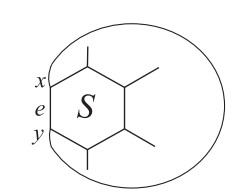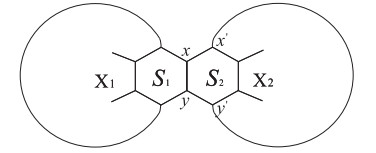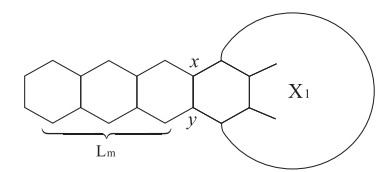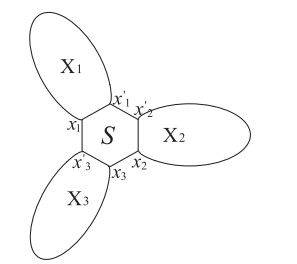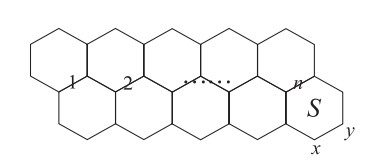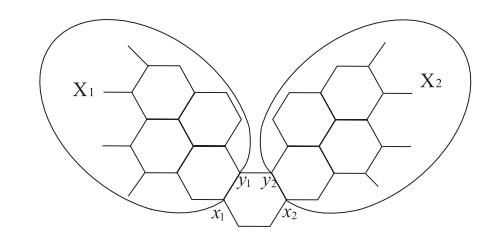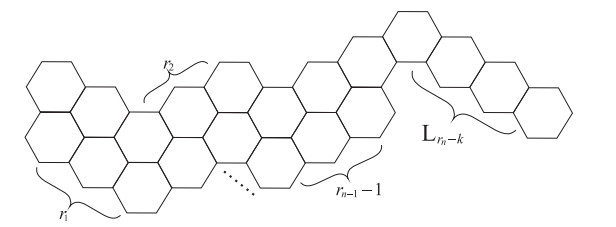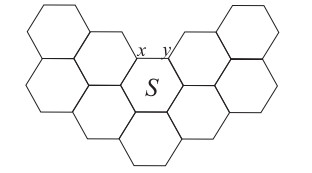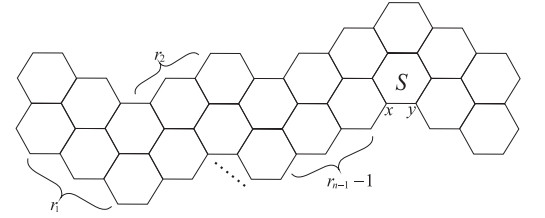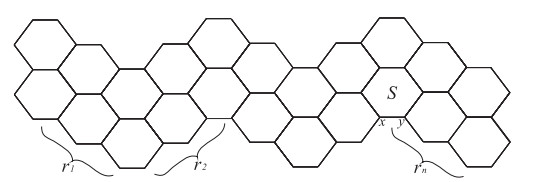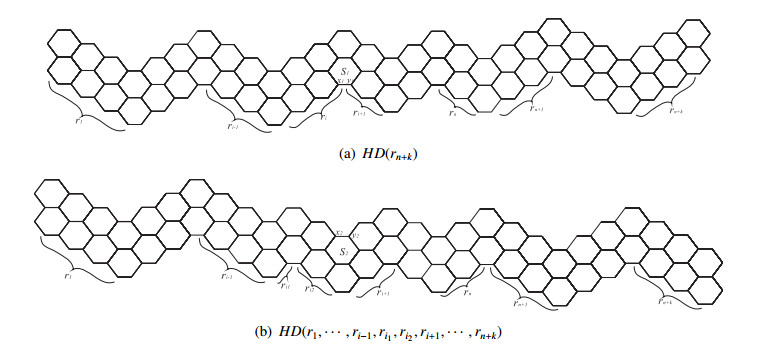1.
Introduction
Polycyclic aromatic hydrocarbons (PAHs) are hydrocarbons with two or more benzene cycle structures in their molecules, such as our common naphthalene, anthracene, phenanthrene, etc. They are the most abundant group of carcinogens and are widely distributed in air, soil, water, and plants, in addition to being an important raw material for the chemical industry. At the same time, the chemical and biological activities of thickened aromatic hydrocarbons make them extremely versatile for applications in the petroleum industry, chemical manufacturing, and pharmaceutical industry, and these activities are dependent on their topology, while topological indicators are numerical descriptors of the topology of a molecule, which can be used as direct numerical descriptors to check the physical, chemical or biological activity of a molecule.
Hexagonal systems are a typical class of PAHs. In graph theory terminology, a hexagonal system (benzene-type hydrocarbons) is a 2-connected planar graph, each of whose internal faces is bounded by a unit regular hexagon with side length 1. The subgraph of a hexagonal system is called a generalized hexagonal system. A hexagonal system H is called a double hexagonal chain if it can be seen as a hexagonal system of naphthalene and naphthalene adhered in a certain way, which is formed by the adhesion of naphthalenes (see Figure 1(a)) in the α-formations, where two naphthalenes are adhered in a downward dislocation, i.e., the vertices b and e, c and f, and d and g are made to coincide, respectively (see Figure 1(b)), or in the β-formations, where two naphthalenes are adhered in an upward dislocation, i.e., the vertices a and f, b and g, and c and h are made to coincide, respectively (see Figure 1(c)).
In 1996 [1], F. Zhang and H. Zhang first introduced the concept of Clar covering polynomials for the hexagonal system diagram H and denoted it. The Clar covering polynomial for the hexagonal system contains many important topological indicators, such as the Kekulé number, the Clar number, and the first Herndon number. It has been shown that the Clar covering polynomials allow more accurate calculation of the chemical activity of PAHs in terms of resonance energy, which is an important theoretical quantity for predicting the aromatic stability of PAH conjugation systems. Therefore, the study of the Clar covering polynomials for PAHs will help to reduce laboratory work on the topological parameters of PAHs and to maintain the ecological natural balance in terms of pollution control and air pollution reduction. The study of the Clar covering polynomials of PAHs will also provide an effective theoretical basis for the generation of unsynthesized PAHs.
Let H be a generalized hexagonal system. A Kekulé structure in H corresponds to a perfect matching of H, that is, the set of mutually disjoint edges in H that cover all the vertices of H. Denote by K(H) the number of Kekulé structures of H, i.e., the number of perfect matchings of H [2]. A hexagonal system is called Kekuléan if and only if it has Kekulé structures. In recent decades, the Kekulé structure has been widely used to describe the local aromaticity of molecules [3,4,5] and predict carbon-carbon bond lengths and the stability of molecules [6]. If no three hexagons share a common vertex in a hexagonal system, then the hexagonal system is called cata-condensed (see Figure 2(a)), otherwise, it is peri-condensed (see Figure 2(c)). If each hexagon is adjacent to at most two hexagons, the cata-condensed hexagonal system is said to be an unbranched cata-condensed hexagonal system (see Figure 2(b)) [6], namely, a hexagonal chain.
Let Q be a set of mutually disjoint hexagons of a generalized hexagonal system H, then H-Q is denoted by a subgraph of H, obtained by deleting all vertices of Q together with their incident edges. Q is said to be a cover of H if H-Q has at least one perfect matching or if H-Q is empty, following Gutman [2]. We add a Kekulé structure of H-Q to the cover Q to get a vertex-cover of H, which is called a Clar cover of a (generalized) hexagonal system H. In other words, a spanning subgraph C of H is said to be a Clar cover of H if each of its components is either a hexagon or an edge.
Let C be the set of all Clar covers of H. For a Clar cover C∈C, we denote by h(C) the number of hexagons of C. Define the Clar covering polynomial of H as follows [1]:
In particular, the Clar covering polynomial of a graph H without any Kekulé structure is satisfied with P(H,w)=0; and the Clar covering polynomial of a null graph H is P(H,w)=1 [1].
In the papers [1,7,8], F. Zhang and H. Zhang gave a series of recursive formulas for Clar covering polynomials and specific expressions for Clar covering polynomials for some special hexagonal chains. Early research on Clar covering polynomials mainly focused on the calculation of several related topological indices associated with them [9,10,11]. Gutman and colleagues [12,13,14,15,16,17,18] demonstrated the relevance between Clar covering polynomials of benzene hydrocarbons and their resonance energy. In 2005 [14], it was proven that when w≈1, lnP(H,w) shows the best correlation with resonance energy, suggesting that P(H,1) can be considered a new structural descriptor, similar to the role of Kekulé structure numbers based on Kekulé structure theory. In the same year [15], Gutman showed that in the case of benzene molecules, the Dewar resonance energy (DRE) and topological resonance energy (TRE) are linearly related to lnP(H,0) and lnP(H,1), respectively. Subsequently, Clar covering polynomials were further investigated and many results were obtained [19,20,21,22,23,24,25,26,27,28,29,30]. For example, in 2006 [20], Gutman and Borovicanin obtained explicit combined expressions for Clar covering polynomials of multiple linear hexagonal chains Mn,m. In 2009 [21], Q. Guo provided explicit recursive formulas for Clar covering polynomials of cyclo-polyphenacenes and determined their Clar numbers, Kekulé structure numbers, and first Herndon numbers. Chien-Pin Chou and others [23,24,25,26] developed an automatic computer program for calculating Clar covering polynomials of small to medium-sized benzene systems and determined specific expressions for Clar covering polynomials of a series of benzene compounds using a self-developed calculation program.
In conjugate circuits, resonance energies are determined using conjugate rings of different lengths [31], not just hexagonal cycles. However, only hexagonal and decagon rings have uniquely determined structures. Therefore, in 2016 [32], Zigert Pleteršek introduced the concept of generalized Clar covering polynomials containing both six- and ten-membered cycles in the literature. In 2022 [33], Boris Furtula and his team, based on the definition of generalized Clar covering polynomials, researched a series of recursive formulas of generalized Clar covering polynomials and provided an algorithm to compute the generalized Clar covering polynomials of any hexagonal chain. They demonstrated that generalized Clar covering polynomials can more accurately estimate and compute the resonance energy of PAHs and other chemical activities, thus being used to predict the aromatic stability of PAH conjugated systems. In the same year [34], Radenković demonstrated that the vibrational energy of a molecule is related to parameters based on the Clair structure by using the generalized Clar covering polynomial.
In addition, the Clar covering polynomials are also associated with various mathematical and chemical concepts. This includes the connection between the Clar covering polynomial and the sextet polynomial [8], the chromatic polynomial [35], as well as the relationship between the Clar covering polynomial and the cube polynomial of their resonance graph [36], and the relationship between the generalized Clar covering polynomial and the generalized cube polynomial of its resonance graph [32]. However, there is not much research on the double hexagonal chain, mainly because the double hexagonal chain belongs to the peri-condensed hexagonal system, and its structure is complex and difficult. Gutman [37] studied the partition of the π-electrons in the rings of linear double hexagonal chains. In 2020, M. Alishahi and S.H. Shalmaee [38] gave the exact formulae for the edge eccentric connectivity index and modified edge eccentric connectivity index of linear double hexagonal chains. In Ref [39,40,41,42], H. Ren and F. Zhang characterized a series of extreme double hexagonal chains, such as the double hexagonal chains with maximal Hosoya index and minimal Merrifield-Simmons index.
In this paper, we first obtained some recursive formulae for the Clar covering polynomials of double hexagonal chains and proposed a Matlab algorithm to compute the Clar covering polynomial of any double hexagonal chain. Moreover, we presented the characterization of extremal double hexagonal chains with maximum and minimum Clar covering polynomials in all double hexagonal chains. For other concepts not described in the text, one can refer to the book [43].
2.
Preliminaries
In this section, we will introduce some relevant conclusions for the Clar covering polynomial of the hexagonal system. F. Zhang and H. Zhang have obtained some properties and recurrence relations for the Clar covering polynomial of a hexagonal system and have derived some formulae for calculating the Clar covering polynomials of some special classes of hexagonal systems.
Theorem 2.1. [1] Let H be a generalized hexagonal system, the components of which are H1, H2, H3, ⋯, Hs, then
Theorem 2.2. [1] Let H be a generalized hexagonal system. Assuming that e=xy is an edge of a hexagon S of H, which lies on the periphery of H (see Figure 3), then
Theorem 2.3. [20] Let H be a generalized hexagonal system. Assuming xy is an edge not belonging to any hexagons of H and the vertex x is of degree 1 (see Figure 4), then
Let H be an any generalized hexagonal system containing the vertex x is degree 1. According to the result of the Theorem 2.3, the Clar covering polynomial of H can be calculated in the following simple way:
Let X1, and X2 be two Kekuléan hexagonal systems. We get a hexagonal system, which identifies an edge on the periphery of X1 with an edge on the periphery of X2, denoted by X1⋅X2 (see Figure 5).
Theorem 2.4. [1] Let X1 and X2 be two Kekuléan hexagonal systems, which contain hexagons S1 and S2, respectively, as indicated in Figure 5 (or let one of them be K2). The Clar covering polynomial of hexagonal system X1⋅X2 is
where X′i=Xi−x−y for i=1 or 2.
Without danger of confusion, we use Lm to denote a linear hexagon chain, and denote lm by the Clar covering polynomial of a linear hexagonal chain with m hexagons.
Corollary 2.1. [1] Let Lm⋅X1 be a hexagonal system (see Figure 6), then P(Lm⋅X1,w)=m(w+1)P(X′1,w)+P(X1,w).
Theorem 2.5. [1] Let X1 and X2 be two Kekuléan hexagonal systems or K2, and G=(X1⋅Lm)⋅X2 (see Figure 7), then
where X′1=X1−x−y, and X′2=X2−x′−y′.
Let X1, X2, and X3 be three Kekuléan hexagonal systems. Identifying each of a triple of pairwise disjoint edges of an additional hexagon with a peripheral edge of X1, X2, X3, denote by X1⋅X2⋅X3 (see Figure 8).
Theorem 2.6. [1] Let X1, X2, and X3 be three Kekuléan hexagonal systems or K2, and let G=X1⋅X2⋅X3 (see Figure 8), then
where X′i=Xi−xi−x′i, for i=1,2,3.
3.
Main results
In the above, some properties and recurrence relations for the Clar covering polynomial of a hexagonal chain have been obtained. In this section, we will deduce the relevant conclusions for the Clar covering polynomial of a double hexagonal chain, and we will consider the sequence relation of the polynomial in the hexagonal chains by quasi-order, which denote ⪯ and ≺. Let f(x)=∑nk=0akxk and g(x)=∑nk=0bkxk be polynomials in x. We write f(x)⪯g(x) if ak≤bk for all integers k, and f(x)≺g(x) if the polynomials are not equal. In the following, we denote by Lαn and Lβn the linear double hexagonal chains containing n naphthalene in the α-formations and β-formations, and lαn and lβn by their corresponding Clar covering polynomials, respectively. Moreover, in this section we will use square brackets [a,b] to denote all real numbers in the closed interval a to b.
Theorem 3.1. Let Lαn be a linear double hexagonal chain containing n naphthalenes (see Figure 9), in which the adhesion of naphthalenes are the α-formations, then
Proof. Obviously, the Clar covering polynomial of naphthalene is lα1=l2=2w+3. Applying Theorem 2.4 to the edge xy, we have
According Theorem 2.3, we have P(Lαn−S,w)=ln−1, P(Lαn−x−y,w)=P(Lαn−1,w)=lαn−1, P(Lαn−xy,w)=ln, and ln=ln−1+w+1.
Therefore,
Similar to the proof of Theorem 3.1, or simply following by symmetry, we have
Corollary 3.1. Let Lβn be a linear double hexagonal chain containing n naphthalenes, in which the adhesion of naphthalenes are the β-formations, then lβn=(w+1)ln(n−1)2+l2n−1.
According to Theorems 2.1 and 2.6, we have the following result:
Theorem 3.2. Let X1 and X2 be two double hexagonal chains or linear hexagonal chains, and G be a hexagonal system as shown in Figure 10, then
where X′1=X1−x1−y1, and X′2=X2−x2−y2.
Let H be a double hexagonal chain, in which has n maximal linear double hexagonal chains with more than two naphthalenes. We in turn denote the number of naphthalenes in these maximal linear double hexagonal chains by r1,r2,⋯,rn (ri≥2, i=1,2,⋯,n), respectively, which is also said to be a related sequence of H. Thus, we can use HD(r1,r2,⋯,rn) (without danger of confusion, abbreviated as HD(rn), see Figure 11(a)) to denote by a double hexagonal chain H with related sequence r1,r2,⋯,rn. We also denote by HD(rn−1) an auxiliary double hexagonal chain from HD(rn) by removing the terminal naphthalene of the last maximal linear double hexagonal chain (see Figure 11(b)), and denote by Hd(rn) and Hd(rn−1) the Clar covering polynomials of HD(rn) and HD(rn−1), respectively. Furthermore, we use Cg(rn−k) to denote the Clar covering polynomial of the following combination graph CG(rn−k) (see Figure 12), where CG(rn−k)=HD(rn−1−1)⋅Lrn−k, k=0,1,⋯,rn−1.
Apply Theorem 3.2 to graph CG(rn−k) and we can obtain the following result:
Proposition 3.1. Let n(≥2) be a positive integer, then the Clar covering polynomial of CG(rn−k) is
Obviously, we have Cg(r1−1)=lr1−1=r1(w+1)+1, and HD(r1) is exactly the linear double hexagonal chain Lαr1. By Theorem 3.1, the Clar covering polynomial of HD(r1) equals to
Therefore, we know that the coefficient of each term in the Clar covering polynomial of Cg(rn−k) is a nonnegative integer.
In the next proposition, we will calculate the Clar covering polynomial of HD(r1,r2) (see Figure 13), and also denote by Hd(r1,r2) the Clar covering polynomial of HD(r1,r2).
Proposition 3.2. The Clar covering polynomial of HD(r1,r2) can be computed as
Proof. To begin, we can apply Theorem 2.2 to the graph HD(r1,r2), then the Clar covering polynomial of HD(r1,r2) can be computed as the following:
and then we apply Theorem 3.2 to Lαr1−1 and Lβr2−1, which are joined by the hexagon S2. We can obtain
Finally, based on Eq (3.1) and some of the elementary calculations, we can obtain the result.
Proposition 3.3. Let n(≥3) be a positive integer, then the Clar covering polynomial of HD(rn) can be computed as
Proof. According to the Theorems 2.2 and 2.6, suppose that S is a hexagon and xy is an edge of HD(rn) as shown in Figure 14, and we have
Thus, Theorems 3.2 and 2.6 enable us to calculate P(HD(rn)−xy,w), and the result is obtained.
Corollary 3.2. Let n(≥3) be a positive integer, then the Clar covering polynomial of HD(rn−1) can be computed as
Proof. According to Proposition 3.3, where lαrn−1 and lrn−1 are replaced by lαrn−2 and lrn−2, respectively.
By Propositions 3.1 and 3.2, we know that each coefficient of each term in Hd(r1−1), Hd(r2−1), and Cg(rn−k) is a nonnegative integer, where r1 and r2 are all larger than 2. Hence, we can obtain that the coefficient of each term in Clar covering polynomials Hd(rn) and Hd(rn−1) are nonnegative integers by Proposition 3.3 and Corollary 3.2.
Due to Propositions 3.1 and 3.3, and Corollary 3.2, we can recursively calculate the Clar covering polynomial of an arbitrary double hexagonal chain. Now we will present a Matlab algorithm (see Table 1) to compute the Clar covering polynomial of an arbitrary double hexagonal chain in the following. In the algorithm, we denote by hi, di and pi by Hd(ri), Hd(ri−1) and Cg(ri−1), respectively. First, in lines 1–3 of the Matlab algorithm, we define the independent variable w, the number of related sequences of HD(rn), and the value of each relevant sequence, respectively. Second, in lines 6–8 of the algorithm, we compute Hd(r1), Hd(r1−1), and Cg(r1−1), respectively, according to Eq (3.1) and Proposition 3.1. Note that when using this algorithm to compute the Clar covering polynomial of an arbitrary linear double hexagonal chain, we need replace line 2 with n=1 and delete line 5. Of course, if we use the algorithm to compute the Clar covering polynomial of an arbitrary double hexagonal chain, we only need to replace lines 2 and 3.
According to the above Matlab algorithm, we can easily compute the Clar covering polynomial of a double hexagonal chain HD(3,2,4,3), as shown in Figure 15, and obtain the following result:
Meanwhile, by the Matlab algorithm, we know that if any two double hexagonal chains have the same related sequence, then their Clar covering polynomials are also the same. We present the exact formulae of the Clar covering polynomials of some double hexagonal chains in the Appendix (see Table 2).
Next, we will calculate the Clar covering polynomial of any arbitrary double hexagonal chain HD(rn) with related sequences r1=r2=⋯=rn=p, and its Kekulé number and the first Herndon number. For simplicity, we denoted by Dpn an arbitrary double hexagonal chain with related sequences r1=r2=⋯=rn=p, its Clar covering polynomial by dpn, and denoted the Clar covering polynomial of Dp′n (which is obtained by removing the terminal naphthalene of the last maximal linear double hexagonal chain from Dpn) by dp′n. In particular, if r1=r2=⋯=rn=2, we also denoted it and its Clar covering polynomial by D2n, d2n, respectively. Meanwhile, denoted by CGpn an auxiliary graph CG(rn−1)=Dp′n−1⋅Lp−1, and its Clar covering polynomial by Cgpn. In particular, when r1=r2=⋯=rn=2, we use Cg2n to denote the Clar covering polynomial of graph CG2n with related sequences r1=r2=⋯=rn−1=rn=2 (see Figure 16(b)), where Cg2n=D2n−1⋅L1.
Proposition 3.4. Let D2n (n≥4) be a double hexagonal chain with related sequences r1=r2=⋯=rn=2 (see Figure 16(a)), then
where d21=w2+6w+6, d22=w3+9w2+21w+14, and d23=w4+10w3+39w2+60w+31.
Proof. Applying Theorem 2.4 to the edge xy and x′y′, respectively, we have that
According to Eqs (3.2) and (3.3), we have that Cg2n=d2n−(w+1)d2n−2, Cg2n−1=d2n−1−(w+1)d2n−3, and
where d21=w2+6w+6, d22=w3+9w2+21w+14 and d23=w4+10w3+39w2+60w+31.
Due to the coefficients of the lowest degree term and the primary term of the Clar covering polynomial equal to the Kelulé number and the first Herndon number, respectively, we can obtain the recurrence relations for the number of perfect matchings and the first Herndon number of D2n by taking w=0 in the Clar covering polynomial and taking w=0 in the first derivative of the Clar covering polynomial in Proposition 3.4, respectively.
The recurrence relations for the number of perfect matchings of D2n (n≥4) are as following:
where K(D21)=6, K(D22)=14 and K(D23)=31.
The recurrence relations for the first Herndon number of D2n (n≥4) are as following:
where h1(D21)=6, h1(D22)=21 and h1(D23)=60.
According to Eqs (3.4) and (3.5) and relevant properties, we give two Matlab algorithms to compute the Kekulé number (or the number of perfect matchings) and the first Herndon number of D2n (see Tables 3 and 4, respectively). Meanwhile, according to the two Matlab algorithms, we can compute the number of perfect matchings and the first Herndon number of some double hexagonal chains (see Table 5).
Now, we will give a more general result for the Clar covering polynomial of a double hexagonal chain with r1=r2=⋯=rn=p.
Proposition 3.5. Let Dpn be a double hexagonal chain with related sequences r1=r2=⋯=rn=p (see Figure 17), then
Proof. Apply Theorems 2.2 and 3.2 to the hexagon S and edge xy in Dpn, we have
then from Proposition 3.1, we have that
According to Eq (3.6), we have that
According to Eqs (3.7) and (3.8) and r1=r2=⋯=rn=p, we can obtain the following recurrence relations for the Clar covering polynomials of dp′n and Cgpn:
for n≥4, where dp′1=lαp−1, dp′2=Hd(m,m−1), dp′3=Hd(m,m,m−1);
for n≥4, where Cgp1=lp−1, Cgp2=dp′1lp−2+(w+1)lp−1, Cgp3=dp′2lp−2+(w+1)Cgp2.
By dealing with dp′n and Cgpn in the same way as Proposition 3.4, we can directly obtain recurrence relations for the Clar covering polynomial of dp′n and Cgpn, and the recurrence relations for the Kekulé numbers and the first Herndon number for Dp′n and CGpn will be obtained. The recurrence relations for the Kekulé numbers and the first Herndon number for Dpn are also obtained.
Next, we will consider the extreme of Clar covering polynomials of double hexagonal chains with the fixed number of naphthalenes. Without loss of generality, we only consider double hexagonal chains represented in Figure 11, being of the reason that any two double hexagonal chains have the same Clar covering polynomials if they have the same related sequence r1,r2,⋯,rn. Let HD(r1,r2,⋯,rn) be the set of double hexagonal chains with a fixed number of naphthalenes, and its related sequences are r1,r2,⋯,rn, then we have the following result.
Theorem 3.3. Let HD(r1,r2,⋯,rn) (abbreviated by HD(rn)) be a double hexagonal chain in HD(r1,r2,⋯,rn), then P(HD(rn),w)⪯dpn, for any fixed positive integer n.
Proof. We prove it by induction on n. It is clearly true that for n=1. For n=2, the result is true for r1=r2=p. In fact, we can obtain the Clar covering polynomial of HD(r1,r2) by Proposition 3.2. Therefore, dp2 is the largest Clar covering polynomial of HD(r1,r2).
Next, assuming that it is true for r1=r2=⋯=rk−1, namely, the Clar covering polynomial of HD(r1,r2,⋯,rk−1), for r1=r2=⋯=rk−1=p, is the largest one. Now, we will prove that the theorem is true for HD(r1,r2,⋯,rk), r1=r2=⋯=rk.
Suppose that r1=r2=⋯=rk−2=p, rk−1=t1, rk=t2, and t1+t2=2p (see Figure 18). According to the induction hypothesis, dpk−2 is the largest Clar covering polynomial of HD(rk−2), for r1=r2=⋯=rk−2=p.
By Theorem 2.4, we have
First, for P(HD(rk)−S1,w), due to the lack of kekulé structure in graphs with odd vertices, then ab does not belong to any kekulé structure of HD(rk)−S1. Hence, according to Theorem 2.1, we have P(HD(rk)−S1,w)=Cg(rk−2−2)⋅Hd(rk−1−1,rk).
Second, for P(HD(rk)−x−y,w) (see Figure 19), applying Theorem 2.2 to the edge x1y1 and hexagon S2, we can obtain P(HD(rk)−x−y,w)=wP(HD(rk)−x−y−S2,w)+P(HD(rk)−x−y−x1−y1,w)+P(HD(rk)−x−y−x1y1,w). Since the Clar covering polynomial of a graph with odd vertices is equal to 0, and we know that the edge cd does not belong to any kekulé structure of HD(rk)−x−y−x1y1, we have P(HD(rk)−x−y,w)=w⋅0+0+Hd(rk−2−2)⋅Hd(rk−1−1,rk).
Finally, for P(HD(rk)−xy,w) (see Figure 20), applying Theorem 2.4 to the edge hg, we can obtain P(HD(rk)−xy,w)=dp′k−3⋅Hd(rk−1,rk)+(w+1)⋅(p−2)⋅dp′k−3⋅P(X1,w)+(w+1)⋅Ggpk−2⋅P(X1,w).
Hence,
Similarly, applying Theorem 2.2 to the edge x3y3, and by Theorem 3.2 and Eq (3.1), we have
obviously, P(X1,w) is maximum when t1=t2.
Meanwhile, according to the induction hypothesis, Cgpk−2, Cg(rk−2−2), dp′k−2, and dp′k−3 are fixed, respectively. By Proposition 3.2, we know that Hd(t1−1,t2) is a maximum when t1=t2, so we can immediately obtain that dpn is the maximum Clar covering polynomial ranging over all Clar covering polynomials of double hexagonal chains in HD(r1,r2,⋯,rn).
Theorem 3.4. Let HD(rn+k) be a double hexagonal chain containing s naphthalenes, with related sequence r1,r2,⋯,ri−1,ri,ri+1,⋯,rn,rn+1,⋯,rn+k, therein ri=p, and p, r1, ⋯, rn+k are nonnegative integers. Thus,
where ri=p, ri1+ri2=p+1.
Proof. Apply Theorems 2.2 and 3.2 to the x1y1 (see Figure 21(a)) and x2y2 (see Figure 21(b)), respectively. We can immediately obtain
where PΔ=lri+1−2Hd′(rn+k,rn+k−1,⋯,ri+2)+(w+1)Cg(rn+k,rn+k−1,⋯,ri+2−1). Obviously, the coefficient of each term in PΔ is a nonnegative integer.
Hence,
Due to the coefficients of each term in Hd(rn), Hd′(rn) and PΔ are nonnegative integers. We will only consider the coefficients of each term in Hd′(ri1)−Hd′(ri−1), Hd′(ri2)−Hd′(ri), Cg(ri2−1)−Cg(ri−1). For the convenience of calculation, set w+1=x in the following, then
(ⅰ) First, consider Hd′(ri1)−Hd′(ri−1). According to Corollary 3.2, we have
(ⅱ) Next, consider Hd′(ri2)−Hd′(ri). According to Theorems 2.4 and 3.2, Proposition 3.2 and Corollary 3.2, we have
where A=x+lαri1−2lαri2−2+xlri1−2lri2−2.
Hence,
Obviously, through simple calculations, we know that the coefficients of each term in lri1−2lαri2−2−lp−2 and lαri1−2lαri2−2−lαp−2 are nonnegative integers, so we have that the coefficient of each term in Hd′(ri2)−Hd′(ri) is a nonnegative integer.
(ⅲ) Eventually, consider Cg(ri2−1)−Cg(ri−1). By Proposition 3.1, Corollary 3.2 and ri1+ri2=p+1, we can obtain
when r1=2 or r1=r2=2, lri2−2lαri1−2+xlri1−2−lp−2=0. If r2=2 and r1≠2, we have lri2−2lαri1−2+xlri1−2−lp−2=(ri1−2)(ri1−1)2x2+(ri1−2)x. Hence, we also know that the coefficient of each term in Cg(ri2−1)−Cg(ri−1) is a nonnegative integer.
To sum up, the proof is completed.
Corollary 3.3. Let HD(rn+k) be a double hexagonal chain containing s naphthalenes, with related sequence r1,r2,⋯,rn,rn+1,⋯,rn+k, therein r1=r2=⋯=ri=p, ri+1=ri+2=⋯=rn=t, rn+1=rn+2=⋯=rn+k=r, i∈[1,n], and p, t, r, i are nonnegative integers. Thus,
where r1=r2=⋯=ri−1=p, ri1+ri2=p+1 and ri+1=ri+2=⋯=rn=t, rn+1=rn+2=⋯=rn+k=r.
Corollary 3.4. Let HD(rn) be a double hexagonal chain containing s naphthalenes, with related sequence r1,r2,⋯,rn, therein r1=r2=⋯=ri=p, ri+1=ri+2=⋯=rn=t, i∈[1,n], and p, t, i are nonnegative integers. Thus,
where r1=r2=⋯=ri−1=p, ri1+ri2=p+1, and ri+1=ri+2=⋯=rn=t.
Corollary 3.5. Let HD(rn) be a double hexagonal chain containing s naphthalenes, with related sequence r1,r2,⋯,rn, therein r1=r2=⋯=rn=p, p≥3, and p is a nonnegative integer, then
where r1=r2=⋯=rn−1=p, rn1+rn2=p+1.
Theorem 3.5. Let HD(rn) be a double hexagonal chain containing s naphthalenes, then d2s−1 is the maximum Clar covering polynomial of HD(rn).
Proof. For any double hexagonal chain containing s naphthalenes, according to Theorem 3.4, we can split it into
where u, v are nonnegative integers, and u, v represent the number of maximal linear double hexagonal chains containing exactly 3 naphthalenes and the number of maximal linear double hexagonal chains containing exactly 2 naphthalenes, respectively.
Hence, we know that u, v must exist and v=0,2,4,⋯,s−1 (if 2∤s) or v=1,3,5,⋯,s−1 (if 2|s). Obviously, we only need to consider the case of v=0or1, since the case of v>1 can be obtained simply by splitting some maximal linear double hexagonal chains of v=0or1 according to Theorem 3.4, i.e., the case v>1 is covered in the process of splitting v=0or1. The following discussion of v=0or1: When v=0or1, we know that any related sequence of a double hexagonal chain containing s naphthalenes can be written as either r1=r2=⋯=ru=3 or r1=⋯=ri−1=ri+1=⋯=ru+1=3,ri=2,i∈[1,u+1], then
(ⅰ) For r1=r2=⋯=ru=3, according to Corollaries 3.4 and 3.5, we split ru,ru−1,⋯r1 one by one into ru1=ru2=2,r(u−1)1=r(u−1)2=2,⋯. Obviously, the Clar covering polynomials get bigger and bigger as we keep splitting them;
(ⅱ) For r1=r2=⋯=ru=3,ru+1=2, it is similar to (ⅰ);
(ⅲ) For ri=2,r1=⋯=ri−1=ri+1=⋯=ru+1(i∈[2,u]), according to Corollary 3.3, we split ri−1,ri−2,⋯r1 one by one into r(i−1)1=r(i−1)2=2,r(i−2)1=r(i−2)2=2,⋯, then according to Corollary 3.4, we split ri+1,ri+2,⋯ru+1 one by one into r(i+1)1=r(i+1)2=2,r(i+2)1=r(i+2)2=2,⋯. Obviously, the Clar covering polynomials get bigger and bigger as we keep splitting them.
To sum up, we can obtain the fact that if the number of naphthalenes in any double hexagonal chain is fixed as s, the Clar covering polynomial of the double hexagonal chain D2s−1 is maximum.
According to the analysis as described above, for any double hexagonal chain HD(rn) containing s naphthalenes, with related sequences r1,r2,...,rn, splitting any one of the maximal linear chains in HD(rn), which makes the Clar covering polynomial of HD(rn) larger, the Clar covering polynomial of a double hexagonal chain containing only one maximal linear chain is minimum. Thus, we have the following result:
Theorem 3.6. Let HD(rn) be a double hexagonal chain containing s naphthalenes, then lαs is the minimum Clar covering polynomial in HD(rn).
4.
Conclusions
Hexagonal systems are a typical class of PAHs. The Clar covering polynomial of a hexagonal system, which is also called a Zhang-Zhang polynomial, unifies several important topological indices used in chemistry. Furthermore, the Clar covering polynomial of a hexagonal system can be used to produce a good approximation to the resonance energy of a hexagonal system. In previous research work, we present extreme hexagonal chains with the maximum and minimum values of the Clar covering polynomials. The double hexagonal chain is a special kind of substructure of the peri-condensed hexagonal system. In this paper, we first obtained some recursive formulae for the Clar covering polynomials of double hexagonal chains and proposed a Matlab algorithm to compute the Clar covering polynomial of any double hexagonal chain. Moreover, we presented the characterization of extremal double hexagonal chains with maximum and minimum Clar covering polynomials in all double hexagonal chains with fixed s naphthalenes.
Use of AI tools declaration
The authors declare they have not used Artificial Intelligence (AI) tools in the creation of this article.
Acknowledgments
We are grateful to anonymous referees for a careful reading of the manuscript and many helpful suggestions. This work was supported in part by National Natural Science Foundation of China Grant 12361072 and 11971406; 2023 Xinjiang Uygur Autonomous Region National Natural Science Foundation General Project (2023D01A36); 2023 Xinjiang Uygur Autonomous Region National Natural Science Foundation For Youths (2023D01B48); 2021 Xinjiang Uygur Autonomous Region National Natural Science Foundation Joint Research Fund (2021D01C078); 2022 Special Foundation for Innovation Team Xinjiang Normal University (2022XJNU).
Conflict of interest
The authors declare no conflicts of interest in this paper.










 DownLoad:
DownLoad:

